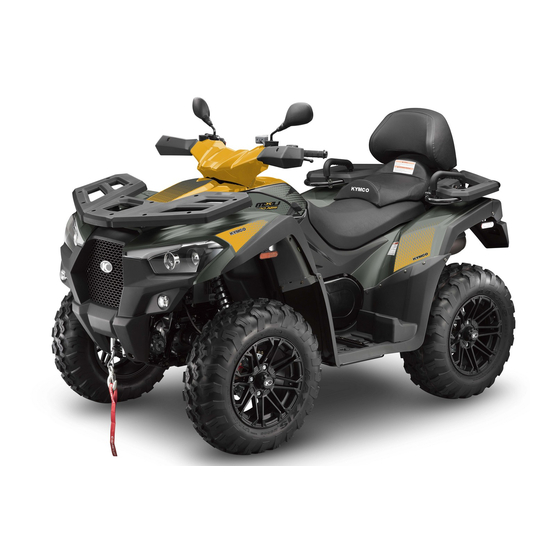
KYMCO MXU700i Manual
Hide thumbs
Also See for MXU700i:
- Owner's manual (166 pages) ,
- Manual (159 pages) ,
- Repair manual (13 pages)
Table of Contents
Advertisement
Quick Links
FOREWORD ................................................................................................... i
PROTECT YOUR SPORT .................................................................................. i
IMPORTANT NOTICES ................................................................................... ii
SAFE RIDING INFORMATION ....................................................................... iii
PREFACE ...................................................................................................... iv
1.
LOCATION OF THE WARNING AND SPECIFICATION LABELS* ........ 1-1
1.1.
LABELS FOR T3b MODELS ........................................... 1-2
2.
SAFETY INFORMATION .................................................................. 2-1
3.
DESCRIPTION AND MACHINE IDENTIFICATION ............................. 3-1
3.1.
KEYS IDENTIFICATION NUMBER .................................. 3-1
3.2.
IDENTIFICATION NUMBER RECORDS .......................... 3-1
3.3.
ENGINE SERIAL NUMBER ............................................ 3-2
3.4.
ENGINE SERIAL NUMBER ............................................ 3-3
3.5.
PARTS LOCATIONS* ..................................................... 3-4
4.
CONTROL FUNCTIONS ................................................................... 4-1
4.1.
IGNITION SWITCH ....................................................... 4-1
TABLE OF CONTENTS
- 1 -
4.2.
INSTRUMENTS AND INDICATOR.................................. 4-2
4.3.
LEFT HANDLEBAR SWITCHES .................................... 4-15
4.4.
Winch switch ............................................................. 4-18
4.5.
EPS/ABS ..................................................................... 4-19
4.6.
TO JUMP START YOUR VEHICLE ................................ 4-20
4.7.
RIGHT HANDLEBAR SWITCH ..................................... 4-21
4.8.
THROTTLE LEVER ....................................................... 4-22
4.9.
SPEED LIMITER .......................................................... 4-23
4.10.
BRAKE ........................................................................ 4-24
4.11.
PARKING BRAKE ........................................................ 4-25
4.12.
LOCKING STEERING ................................................... 4-26
4.13.
DRIVE SELECT LEVER ................................................. 4-27
4.14.
FUEL TANK CAP ......................................................... 4-28
4.15.
SPARK PLUG INSPECTION .......................................... 4-29
4.16.
BATTERY INSPECTION................................................ 4-29
4.17.
SEAT ........................................................................... 4-30
4.18.
FLAG POLE BRACKET ................................................. 4-31
4.19.
TRAILER HITCH* ........................................................ 4-31
Advertisement
Table of Contents
















Need help?
Do you have a question about the MXU700i and is the answer not in the manual?
Questions and answers